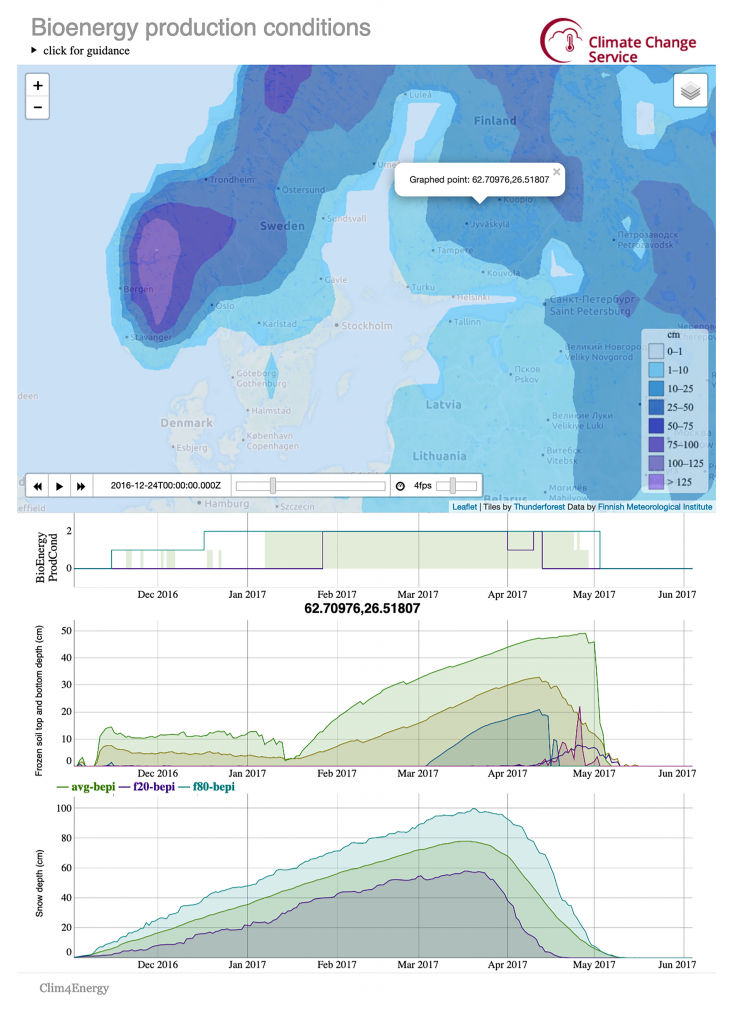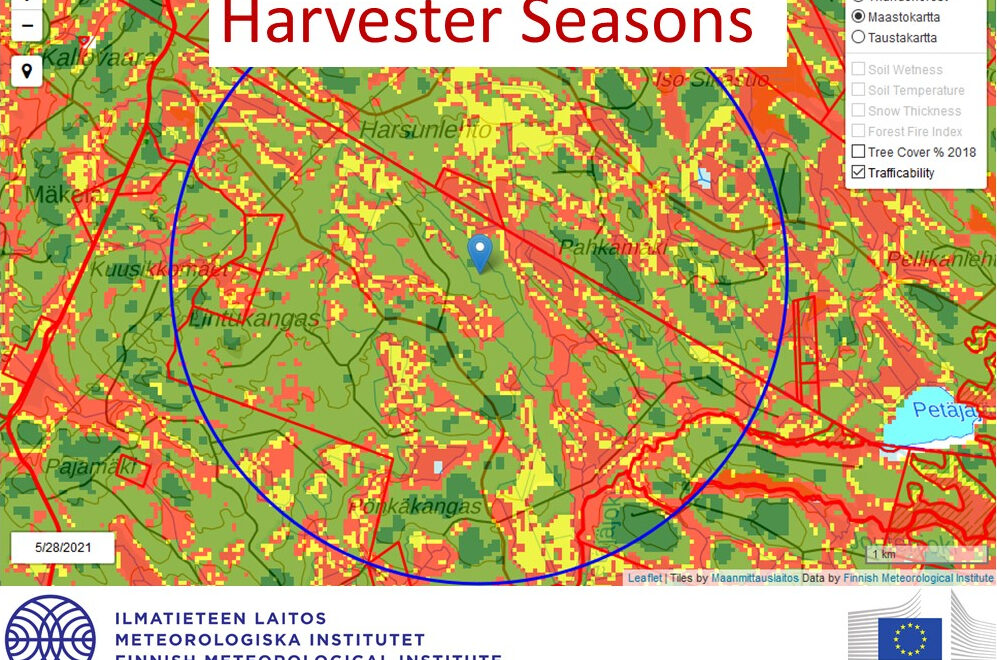Novel services to support growth of bioeconomy and management of risks to forestry are crucially needed. Within the Copernicus Climate Change Service (C3S) project Clim4Energy, a proof of concept for a soil bearing indicator was developed and demonstrated. This indicator aimed to support the planning in timing winter harvesting operations for current machinery.
MIKKO STRAHLENDORFF (1), HEIKKI PAJUOJA (2), HILPPA GREGOW (1)
(1) Finnish Meteorological Institute, (2) Metsäteho Oy
In Finland, Bioeconomy is a vital element of societal welfare. For instance, pulp factories have grown to produce also energy, renewable fuel and other chemicals. Pulpwood is a major resource to be secured sustainably, but also economically. In 2014, the Finnish Government set an aim for the Bioeconomy sector to create 100 000 new jobs by 2025.
Mitigation goals and climate change impacts on the forestry sector are difficult to combine economically. Finland’s forests have been growing fast during recent decades due to increasing warming. At the same time the winter ground bearing has weakened and harvesting conditions have become worse (Gregow et al., 2011 and Siren M., 2000).
Within the project Clim4Energy, the Finnish Meteorological Institute and Metsäteho Oy co-developed an indicator, which is simple to use to assess winter conditions for harvesting operations. Soil bearing in boreal zone is known to be excellent with soil freezing to 20 cm depth or snow cover being 40 cm thick (Eeronheimo 1991). If one of the two is met, it awards good conditions. Poor conditions were estimated for less than 5 cm of frozen soil and less than 10 cm snow depth. Frozen soil depth input is not directly available in reanalysis (Dee et al., 2011) or numerical forecast data. Based on our evaluation, using model soil temperature at available depth layers (0–7 cm, 7–28 cm, 28–100 cm, 100–289 cm) is not realistic either – soil freezes too deep and too fast compared to observed freezing. An empirical equation for frozen soil depth (fsdt = prev + 0.0591 – (t2m – 273.15) * 0.079 – sd 0.0161 (Gregow et al., 2011)) based on relations from soil freezing observations to daily 2m air temperature (t2m in K) and snow depth (sd in m) is applicable and was used in our proof of concept.
The bioenergy production condition indicator shows the areas and timing of good conditions (value=2) both in time and space (Fig. 1). It also indicates when the conditions are poor (value=0) or uncertain (1). The indicator was used when piloting seasonal forecasts of the bioenergy production conditions during winter 2016–2017. The demonstrations are available at http://c4e.fmi.fi/.

Map shows frozen soil depth on 24.12.2016 and graphs depicting mean and ensemble quantiles 20 and 80 for the indicators frozen soil depth and snow depth.
Acknowledgements: Copernicus C3S Clim4Energy project funded this effort.
References
Dee, D. P., et al., 2011: The ERA-Interim reanalysis: Configuration and performance of the data assimilation system. Quart. J. Roy. Meteor. Soc., 137, 553–597.
Eeronheimo, O., 1991: Suometsien puunkorjuu. Folia Forestalia 779, 29 p.
Gregow H., et al.; Ilmatieteen laitos Raportteja 2011:5 Lumettoman maan routaolojen mallintaminen ja ennustettavuus muuttuvassa ilmastossa.
Kellomäki, S., et al., 2010: Model computations on the Climate Change Effects on Snow Cover, Soil Moisture and Soil Frost in the Boreal Conditions over Finland. Silvia Fennica 44(2).
Sirén, M., 2000: Metsätieteen aikakauskirja 2/2000; Turvemaiden puunkorjuun kehittäminen.
HOW TO CITE THIS ARTICLE:
Strahlendorff M., Pajuoja H.., and Gregow H., 2019: Bioenergy production condition indicator for managing risks to forestry for Copernicus Climate Change Service, FMI’s Climate Bulletin: Research Letters, 1(1), 11, DOI: 10.35614/ISSN-2341-6408-IK-2019-09-RL
CITATION INFORMATION:
Authors: Mikko Strahlendorff, Heikki Pajuoja, and Hilppa Gregow
Received: March 28, 2019
Accepted: June 11, 2019
First online: June 19, 2019
Published: June 20, 2019
Journal: FMI’s Climate Bulletin: Research Letters
Volume: 1
Issue: 1
Page: 11
DOI: 10.35614/ISSN-2341-6408-IK-2019-09-RL
Header image: Eija Vallinheimo


